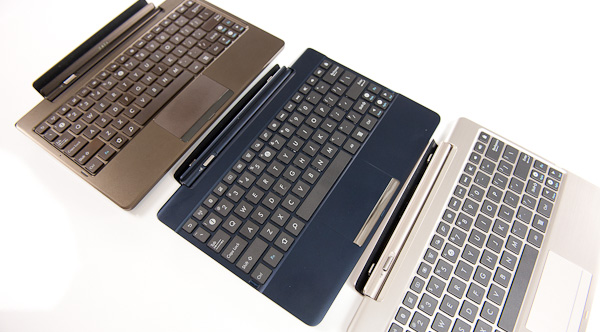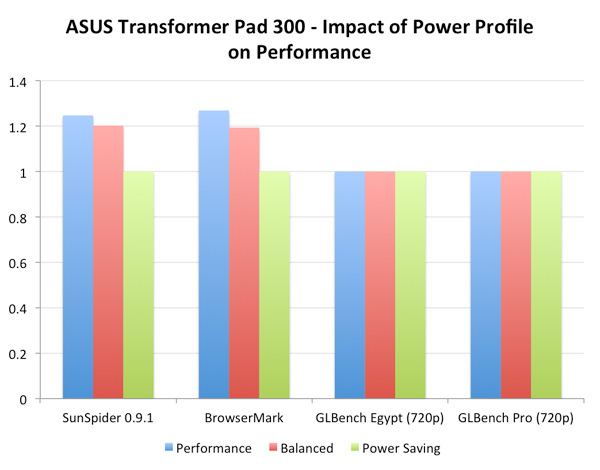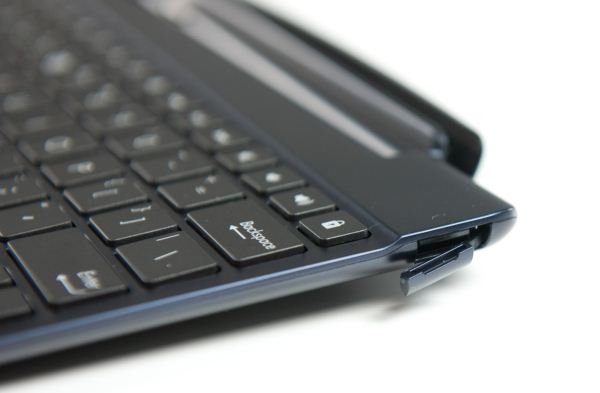ASUS Transformer Pad 300 (TF300T) Review
by Anand Lal Shimpi on April 22, 2012 3:00 AM ESTThe Dock
As this is still a Transformer, you can purchase an optional Transformer dock in a matching color for the 300:
The dock, as always, adds a QWERTY keyboard, trackpad, integrated 16Wh battery, full sized USB 2.0 port and SD card reader. The battery capacity is down from the Prime's dock (22Wh) and as a result extends battery life less than it does in the case of the Prime. I believe we're looking at a classic case of segmentation here, but even so the dock's integrated battery continues to be a brilliant part of the Transformer platform. Not only does it power the keyboard and touchpad but it also charges the 300's battery when docked.
![]()
Google has even added support for external batteries like the Transformer Pad's in Ice Cream Sandwich and you'll actually get two battery status indicators, in addition to an animation showing you how one is charging the other.

From left to right: Transformer dock, TF Pad 300 dock, TF Prime dock
The 300's dock is otherwise nearly identical to the Prime's dock, though it is modified to accommodate the thicker tablet. You can technically use the Prime in the 300's dock but the fit isn't quite secure due to the Prime's thinner form factor. Conversely, the 300 won't fit in the Prime's dock nor the original Transformer's dock - although the actual 40-pin dock connector remains unchanged. The price for the dock is still at $149, identical to what the Prime and original Transformer versions sold for.
The same limitations that came with those older docks apply here as well. With the tablet docked, the contraption is extremely back heavy and can tilt backwards if you're typing on your lap (or any non-flat surface) unless your hands are on the keyboard. The touchpad offers no real protection against accidental taps, although you can disable it via a function key on the keyboard. Although the docked tablet may look like a notebook, the construction isn't quite as solid as an inseparable unibody ultraportable design. The docked TF Pad may look like a Zenbook, but the Zenbook is always going to be more solid (and more expensive) for obvious reasons.
One nitpick I have about the TF Pad 300's dock is the return of the dangling USB port cover. ASUS had something similar on the first Transformer dock, but replaced it with a fully removable rubber stopped for the Prime. On the TF300T, it's back:
All of that said, the dock continues to be the best route for folks who want to do a ton of typing on their tablet - without giving up the portability and convenience of the tablet form factor. On trips you can choose to carry both pieces or just one if you don't plan on doing a lot of typing. At home you can quickly dock and undock the tablet as you shift between usage modes.
Updated Internals
Internally, the Transformer Pad 300 is once again more Prime than original Transformer. Whereas the original Transformer used an NVIDIA Tegra 2 SoC, the Prime and Transformer Pad 300 both use a quad-core (technically 4+1) NVIDIA Tegra 3 SoC. The two differ in their maximum clock speeds.
The Transformer Prime's SoC can run a single core at up to 1.4GHz, and 1.3GHz with more than one core active. The Tegra 3 in the Transformer Pad 300 on the other hand runs at a maximum of 1.3GHz (1 core active) or 1.2GHz otherwise. Note that this difference only exists in the maximum performance mode. Running the balanced power profile, the 300 like the Prime before it runs at a maximum of 1.2GHz regardless of number of active cores. In practice I saw the 300 typically top out at 1.1GHz and only rarely peak at 1.2GHz with the balanced power profile active (see: the three power profiles below).
The Prime's clocked its GPU somewhere around 500MHz, however the TF Pad 300's GPU runs around 400MHz.
| NVIDIA Tegra 3 | ||||
| Max CPU Clock | Max GPU Clock | |||
| NVIDIA Tegra 3 (T33) | 1.6 - 1.7GHz | ? | ||
| NVIDIA Tegra 3 (T30) | 1.4GHz | ~500MHz | ||
| NVIDIA Tegra 3 (T30L) | 1.3GHz | ~400MHz | ||
It's clear that NVIDIA is employing a binning strategy with its Tegra 3 in order to make good use of parts of all yields. The T30 employed in the Transformer Prime ships at nominal clocks, while higher leakage parts (T33) will be used in the upcoming Transformer Pad Infinity that will run at up to 1.6 - 1.7GHz. The lower leakage/lower binning parts (T30L) get used by the Transformer Pad 300, and likely carry a slightly lower cost to ASUS as well.
One advantage the Transformer Pad 300 has internally compared to the TF Prime is its memory. While every single Transformer released thus far has shipped with 1GB of RAM, the 300 is the first to use 1.5V DDR3-667. The TF Prime used 1.5V DDR2-500 as far as I can tell. Don't expect any power savings from the new DRAM, but I believe this is a precursor to the Transformer Pad Infinity with its higher memory bandwidth demands.
I should also add that technically we're reviewing the ASUS Transformer Pad TF300T, the trailing T is for Tegra. ASUS has mentioned that it may introduce 3G and/or LTE equipped versions, the latter would presumably ship with Qualcomm's S4 SoC.
The Three Power Profiles
With the Transformer Prime, ASUS exposed the CPU governor settings for user control via three selectable power profiles. These profiles were originally named Normal, Balanced and Power Saving, however they have since been renamed Performance, Balanced and Power Saving. The behavior of the modes on the Transformer Pad 300 vs. the Prime is below:
| ASUS Transformer Power Profile Settings | ||||
| TF Pad 300 | TF Prime | |||
| Performance |
Max 1C Speed: 1.3GHz Otherwise: 1.2GHz |
Max 1C Speed: 1.4GHz Otherwise: 1.3GHz |
||
| Balanced | Max CPU Speed: 1.2GHz | Max CPU Speed: 1.2GHz | ||
| Power Saving |
Max 1C/2C Speed: 1.0GHz Max 3C Speed: 760MHz Max 4C Speed: 620MHz |
Max 1C/2C Speed: 1.0GHz Max 3C Speed: 760MHz Max 4C Speed: 620MHz |
||
At a high level the main difference between the power profiles is the max CPU speed in performance mode. In Balanced and Power Saving modes these two appear to be equal. The reality is a bit more complex as the Prime tends to deliver lower performance in its Power Saving mode compared to the 300. There's also something funny going on with GPU performance in the Power Savign mode on the 300. With Vsync disabled, there's no performance difference between Power Saving, Balanced and Performance modes on the 300. With Vsync enabled however, we see a ~22% drop in GPU performance with Power Saving enabled.

In general, there's no real performance benefit to using Performance mode but a potentially tangible drop in CPU performance if you switch to power saving. The problem with the latter is that you may not save all that much power as max one or two core clocks aren't much lower than they are under Balanced mode (1.0GHz vs. 1.2GHz). We saw this echoed in our battery life results later on.












37 Comments
View All Comments
shriganesh - Monday, April 23, 2012 - link
Asus rocks! My original Transformer got ICS 4.0.3 update just a few days back! ICS is great and shuttering is gone! UI is much better and feels smooth!Netscorer - Monday, April 23, 2012 - link
Even though I like the idea of dockable keyboard, from practicality perspective we would need to wait for Windows 8 tablet for this to take off. I just don't see Android ICS as a serious notebook replacement. Given the rest of the specs, for only $100 more one can get an iPad with vastly better screen, battery life, GPU and other characteristics that actually do matter in tablet. I am not trying to compare ICS with iOS5 here as both have they merits but we should also consider the maturity of the App Market comparing to Google Play and other Android contenders.Finally, ASUS have yet to prove that it can ship any significant volume of their tablets. I wanted to buy the original Transformer but for two months could not find any stock and then cooled to the idea. I was following the Infinity model again with no stock until new iPad was already on the market. What are the odds that ASUS will suddenly release this model in quantity?
I'm sorry ASUS but for Pad to take off, you would need to price it at no more then $350 (with 32GB of RAM) and a $100 dock. Otherwise no-one outside of the geek community would even consider your tablet as an alternative to iPad.
Naguz - Monday, April 23, 2012 - link
If only they had included a USB port on the tablet itself - along with a display connector you could connect a VGA adapter to for presentations.dreddit - Tuesday, April 24, 2012 - link
Hey guys are you sure the dimension for the infinity are correct. If so then the Bezel must be much smaller than the primes, by 10mm either side.The asus web site still has dimensions the same as the prime. I hope it is a smaller form factor but with the same 10.1 ips screen
Lucian Armasu - Tuesday, April 24, 2012 - link
Put a dual core (or quad core next year) Cortex A15 chip at 2 Ghz in it, and with a 2560x1600 resolution at 11.6", and I'll take it. There's no way an x86 device with Windows 8 would be in the same price range. It would probably be closer to $1000 than $500.slagar - Wednesday, April 25, 2012 - link
Looks like another fine ASUS product.Absolutely second Anand's comments regarding one of these with Windows 8 later this year. I can't wait to see what happens :)
Thanks for the great info and reviews as always Anandtech!
Anonymous1a - Saturday, August 4, 2012 - link
I absolutely love Asus' product range but the only problem I have with them is that they don't have their own direct store. Although the base models are easily available on the internet, finding a 3G version of the TF300 is like finding a needle in a haystack and the only place I found the needle was ebay and at ridiculously high prices (600+) and considering the fact that two models have already come out after it and the iPad 2 has it's 3G version at 529, this is just wayyy too high, with these vendors exploiting the lack of a direct chain and lack of availability of these products. And there was literally nowhere I could the the Infinity or Prime with LTE anywhere. I wish they would, at least, for a few major markets like USA and UK have their own direct online selling point.